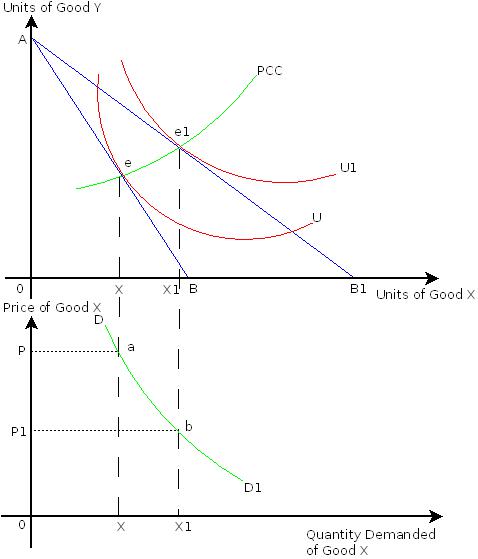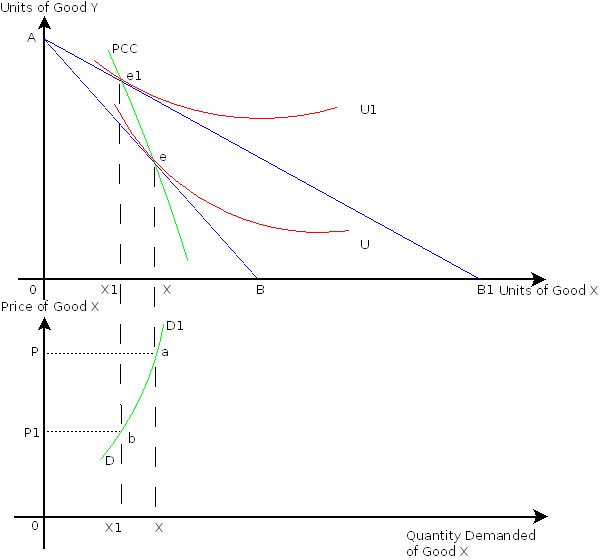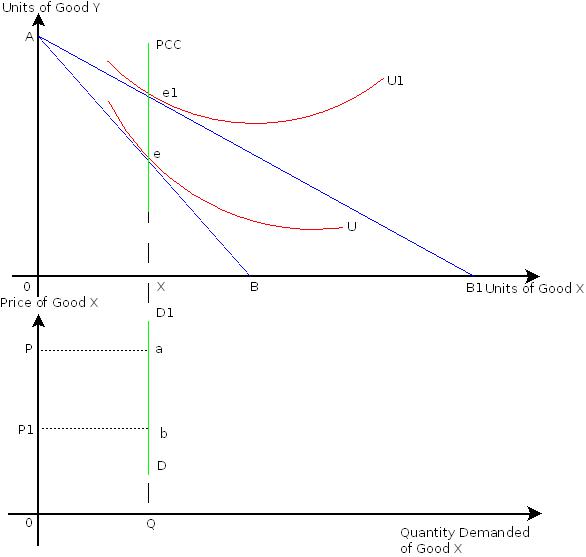INDIFFERENCE CURVES ANALYSIS: DERIVATION OF THE DEMAND CURVE
MICROECONOMICS

|
DERIVATION OF THE CONSUMER'S DEMAND CURVE |

|
Introduction |
r,,gtv

|
Learning Objectives |
| After reading this chapter, you are expected to learn about: understand 1. 2.
| |
| Derivation of the Consumer's Demand Curve: Normal Goods |
We have already seen how the price consumption curve traces the effect of a change in price of a good on its quantity demanded. However, it does not directly show the relationship between the price of a good and its corresponding quantity demanded. It is the demand curve that shows relationship between price of a good and its quantity demanded. In this section we are going to derive the consumer's demand curve from the price consumption curve . Figure.1 shows derivation of the consumer's demand curve from the price consumption curve where good X is a normal good.

The upper panel of Figure.1 shows price effect where good X is a normal good. AB is the initial price line. Suppose the initial price of good X (Px) is OP. e is the initial optimal consumption combination on indifference curve U. The consumer buys OX units of good X. When price of X (Px)falls, to say OP1, the budget constraint shift to AB1. The optimal consumption combination is e1 on indifference curve U1. The consumer now increases consumption of good X from OX to OX1 units. The Price Consumption Curve (PCC) is rising upwards.
Chart.1 shows the demand relationship derived form the price consumption curve.

The lower panel of Figure.1 shows this price and corresponding quantity demanded of good X as shown in Chart.1. At initial price OP, quantity demanded of good X is OX. This is shown by point a. At a lower price OP1, quantity demanded increases to OX1. This is shown by point b. DD1 is the demand curve obtained by joining points a and b. The demand curve is downward sloping showing inverse relationship between price and quantity demanded as good X is a normal good.
| Derivation of the Consumer's Demand Curve: Giffen Goods |
In this section we are going to derive the consumer's demand curve from the price consumption curve in the case of inferior goods. Figure.2 shows derivation of the consumer's demand curve from the price consumption curve where good X is an inferior good.

The upper panel of Figure.2 shows price effect where good X is an inferior good. AB is the initial price line. Suppose the initial price of good X (Px)is OP. e is the initial optimal consumption combination on indifference curve U. The consumer buys OX units of good X. When price of X Px) falls, to say OP1, the budget constraint shift to AB1. The optimal consumption combination is e1 on indifference curve U1. The consumer now reduces consumption of good X from OX to OX1 units as good x is inferior. The Price Consumption Curve (PCC) is rising upwards and bending backwards towards the Y-axis.
Chart.1 shows the demand relationship derived form the price consumption curve.

The lower panel of Figure.2 shows this price and corresponding quantity demanded of good X as shown in Chart.2. At initial price OP, quantity demanded of good X is OX. This is shown by point a. At a lower price OP1, quantity demanded decreases to OX1. This is shown by point b. DD1 is the demand curve obtained by joining points a and b. The demand curve is upward sloping showing direct relationship between price and quantity demanded as good X is an inferior good.
| Derivation of the Consumer's Demand Curve: Neutral Goods |
In this section we are going to derive the consumer's demand curve from the price consumption curve in the case of neutral goods. Figure.3 shows derivation of the consumer's demand curve from the price consumption curve where good X is a neutral good.

The upper panel of Figure.3 shows price effect where good X is a neutral good. AB is the initial price line. Suppose the initial price of good X (Px) is OP. e is the initial optimal consumption combination on indifference curve U. The consumer buys OX units of good X. When price of X (Px)falls, to say OP1, the budget constraint shift to AB1. The optimal consumption combination is e1 on indifference curve U1 at which the consumer buys same OX units of good X as it is a neutral good. The Price Consumption Curve (PCC) is a vertical straight line.
Chart.3 shows the demand relationship derived form the price consumption curve.

The lower panel of Figure.3 shows this price and corresponding quantity demanded of good X as shown in Chart.3. At initial price OP, quantity demanded of good X is OX. This is shown by point a. At a lower price OP1, quantity demanded remains fixed at OX. This is shown by point b. DD1 is the demand curve obtained by joining points a and b. The demand curve is a vertical straight line showing that the consumption of good X is fixed as good X is a neutral good.
